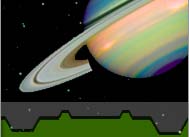Astronomers announced today that stars can be born
big, but only so big.
Theories over the years have predicted that an upper
limit on stellar mass existed somewhere between 10 and
1,000 times the mass of our Sun. Recent observations of
a massive cluster of stars in the center of our galaxy
has found that this mass cutoff is about 150 times the
Sun.
"The primary result is that there is a cutoff. There
is little uncertainty about that," said Don Figer from
the Space Telescope Science Institute. "The secondary
result is that it is about 150 solar masses."
Figer used the Hubble Space Telescope to measure the
masses of stars in the Arches Cluster, which is 25,000
light-years away and ten times the size of typical
clusters in our galaxy. A cluster is a conglomeration of
stars that all formed pretty much at the same time.
"The Arches Cluster contains many more smaller mass
stars than larger mass stars. This is typical for a
cluster," Figer said during a NASA teleconference
today.
The rarity of behemoth stars is one of the reasons it
has been so hard to nail down an upper limit for stellar
mass. But the best place to find the biggest stars is in
the biggest clusters. Arches, which contains 10,000
solar masses - is our galaxy's largest known open
cluster. (Note that there are larger globular
clusters.)
"The richer the cluster, the more likely you are to
find extremely large stars," said Sally Oey from the
University of Michigan, who was not involved in Figer's
research.
Oey and her collaborators have looked for the most
massive stars in nine clusters of a smaller, more
typical size. They were able to estimate an upper limit
that agrees with Figer's more statistically robust
result.
Live fast and die young
It has long been known that a
ball of gas weighing less than about a tenth of our
Sun's mass will not be able to light the fusion
reactor in its core. Once turned on, though, bigger
stars burn brighter. A star 100 times more massive than
the Sun will be a million times brighter, said Stan
Woosley from University of California, Santa Cruz.
But these big stars burn their nuclear fuel more
quickly. Stars greater than 100 solar masses will only
live about 3 million years - compared to our Sun which
is expected to live for more than 10 billion years.
Therefore, to catch a glimpse of a giant star, one has
to look not only at a big cluster, but a young one as
well.
Fortunately, the Arches Cluster is between 2 and 2.5
million years old. With Hubble's acute eye, Figer found
stars there ranging in size from 2 to 130 solar masses.
"We expected to find 20 to 30 stars with masses
between 130 and 1,000 solar masses," Figer said. "But we
found none. If they could have formed, we would have
seen them."
If the prediction had been smaller - say, one or two
behemoth stars - then Figer could explain their absence
as just bad luck. But this big of a drop-off can only be
explained by a physical barrier to more massive stars.
Limiting formation
No one is yet sure what this physical barrier is.
Woosley thought there were two likely scenarios: either
something stops the star's growth early on, or the star
forms, but its intense radiation causes it to blow
apart.
Still, there may be stars that circumvent the 150
solar mass limit. For example, the
mass-spewing Pistol star may weigh as much as 200
solar masses. One way to explain this apparent paradox,
Figer said, is that the Pistol star could be a
"born-again" star, formed from the merger of two smaller
stars. This sort of formation mechanism would be very
unusual, however.
"There is no star in the galaxy that credibly breaks
the 150 solar mass limit," Figer said.







.gif)